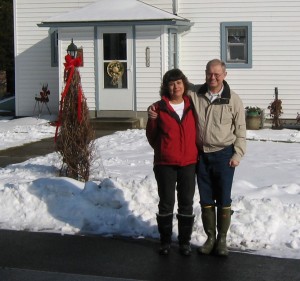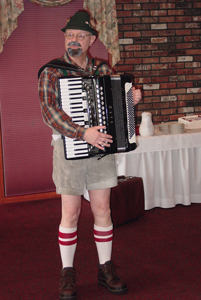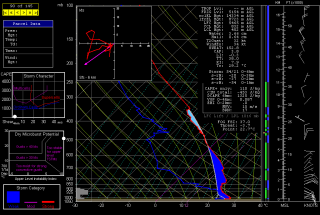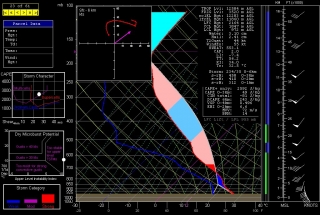Two of the handier implements in a storm chaser’s forecasting toolkit are the skew-T/log-P and the hodograph. These two charts typically come bundled together, furnishing vertical slices of the upper air that show graphically how the atmosphere is behaving—or, in the case of forecast soundings, is projected to behave—from 100 millibars all the way down to the surface.
If you want to see at a glance how unstable the atmosphere is and how much convective inhibition suppresses that instability, look at a skew-T. If you want to know in what direction and how fast storms are likely to move and how much low-level helicity they’re likely to ingest, consult a hodograph. The skew-T and hodograph, along with a multitude of derived indices that often attend them, provide a wealth of vital information.
Soundings can be obtained from a variety of sources, many of them free. Among those sources, RAOB is in a league of its own. Its website homepage describes it as “the world’s most powerful and innovative sounding software. Automatically decodes data from 45 different formats and plots data on 12 interactive displays including skew-Ts, hodographs, & cross-sections. Produces displays of over 200 atmospheric parameters including icing, turbulence, wind shear, clouds, inversions and more.”
A couple years ago, I purchased the Basic module and several others—the Analytic, the Hodograph and Interactive, the Advanced Cross-Section, and the Special Data Decoders—and thus gained empirical familiarity with the powers of RAOB. It is an amazing program, all the moreso for its ease of use. Yet I have to confess that I’ve only scratched its surface. I simply don’t have the know-how to tap into its full capabilities. The more meteorologically and technically astute a user is, and the deeper one wants to dig into the atmosphere, the more RAOB will deliver.
In this interview, RAOB developer John Shewchuk talks about his brainchild. John presents his bio thus:
 My life in three steps: (1) Born at West Point, New York—so I knew I wanted to be a military guy. (2) Started playing the accordion at age eight—because my parents told me to. (3) Got interested in weather during high school—because it fascinated me. Putting the three all together, I went to Penn State for my meteorology degree while playing the “Rain, Rain Polka” at parties for extra income, and I graduated with an ROTC commission in the Air Force. After twenty-two years in the USAF Weather Service, I retired as a lieutenant colonel.
My life in three steps: (1) Born at West Point, New York—so I knew I wanted to be a military guy. (2) Started playing the accordion at age eight—because my parents told me to. (3) Got interested in weather during high school—because it fascinated me. Putting the three all together, I went to Penn State for my meteorology degree while playing the “Rain, Rain Polka” at parties for extra income, and I graduated with an ROTC commission in the Air Force. After twenty-two years in the USAF Weather Service, I retired as a lieutenant colonel.
I am now back in my hometown of Matamoras, Pennsylvania, in the house that my grandpa built. Here I operate the RAOB factory with loving assistance from my wife, Elaine. Of course, that assistance remains loving as long as I also play music other than polkas, like maybe “Stormy Weather” or “Misty” and songs from the Four Seasons group.
That’s John in his own words. I will add one other thing: he is one of the most service-oriented persons you’re ever likely to encounter. While I forget what my first support issue involved, I haven’t forgotten John’s response. He was right there, responding quickly and helpfully, and he has continued to be “right there” ever since.
Be forwarned, the following is a lengthy interview. I’ve considered breaking it into two installments, but I don’t think it lends itself well to that approach. So I’m leaving it intact, trusting that storm chasers, meteorologists, and anyone interested in cutting-edge weather technology will find this post worth reading in its entirety.
Interview with RAOB Developer John Shewchuk
.
Question: RAOB is incredibly sophisticated weather software. I understand that it is the most powerful of its kind in the world—true? What is your background that equipped you to create it?
John: True in that no other program offers the same degree of functionality and capability in a very user-friendly interface. My twenty-two years in the USAF Weather Service and eight worldwide assignments were fundamental to my knowledge of meteorology. College academics were a good start, but the hands-on, daily routine of creating weather maps and issuing operational forecasts were invaluable to understanding how weather really works.
The majority of my severe weather experience comes from eleven years of multiple assignments at Offutt Air Force Base in Omaha, Nebraska. Other valuable experiences came from duties as a science officer and while stationed at the Typhoon Warning Center in Guam.
But knowledge of meteorology is only part of the story; computer programming is the other part. While at college, I also became fascinated with the power of computer code and spend many hours dabbling with Fortran IV. That interest remained mostly dormant while in the Air Force, as I only used automation as it related to daily duties. But when the personal computer hit the public market, I bought my first PC, the Tandy 1000.
Wow, what power! What a thrill to be able to channel electrons into intelligent processes through computer code. My life had changed dramatically, and my accordion became jealous. I taught myself Visual Basic (since it was similar to Fortran) and began to write small DOS programs. I soon upgraded to a VGA  color monitor, a dot-matrix printer, a second floppy disk drive, and more memory. And then, after some deliberation—about two seconds—I went all the way. I broke open my piggy bank and got my first harddrive. Six hundred dollars for a whopping 20 Mb—what a deal! I had now attained nirvana.
color monitor, a dot-matrix printer, a second floppy disk drive, and more memory. And then, after some deliberation—about two seconds—I went all the way. I broke open my piggy bank and got my first harddrive. Six hundred dollars for a whopping 20 Mb—what a deal! I had now attained nirvana.
I started to write small computer games for my kids and utilities for myself and others. I later began publishing computer and software articles for a PC magazine and won some programming contests. And just to remain in good standing with my accordion, I joined a local community polka band and performed at some fun Octoberfests at California’s Big Bear Lake and other local events. I just love those oompah bands! I later appeared as the guest PJ (Polka Jockey, versus the more traditional DJ or Disk Jockey) for my wife’s surprise retirement party. I used the fake beard and mustache to hide my identity since I wasn’t part of the oompah musicians union.
Q: What first inspired you to create RAOB, and when did you begin working on it? How long did it take before the first version was ready for release?
J: While programming games for the kids and utilities for others, I never considered meteorological applications. I instead used the time as a diversion from work—more like relaxation. During this time, I was aware that there were a very few, simple skew-T programs available, but only to large platform government and corporate entities.
But then toward the end of my Air Force career, I heard that one company was creating an advanced interactive weather display and skew-T system for military use for some very big bucks. So then I said, “Hmm, I think I can do a better job for much less.” That was twenty-four years ago.
I soon stopped programming kids’games and started the slow and systematic construction of a skew-T program. Remember, this was all off-duty time, during nights and weekends, and was still in the good old DOS days. My goal was never to market the program, but only to use it as my personal analysis tool, since after military retirement, I planned to use the program to help me with my intended weather consulting business.
In the end, that consulting business never amounted to much. However, soon after beginning the skew-T project, I met Richard Cale at a local American Meteorological Society monthly meeting. Richard (now deceased) had a very successful weather consulting business and helped me obtain my license as a Certified Consulting Meteorologist.
More importantly, for the previous ten years, Richard had been developing advanced upper-air applications on his hand-held, programmable Texas Instrument calculator (a TI-59) while tediously hand-plotting skew-T diagrams. Within twenty-four hours we met again and began a wonderful collaboration on the skew-T project. In return for access to his analysis notes and algorithms, I gave him exclusive use of the developing skew-T program, now called RAOB.
Over the next several months, RAOB developed into a functional skew-T program that could accurately process and plot sounding data using a simple user format. At Richard’s insistence, I added graphic interactive capabilities, which made RAOB a powerful data interrogation tool. These interactive capabilities, such as click-and-drag and other graphic editing features, made RAOB ideal for atmospheric research and forensic applications—perfect for a consulting meteorologist or anyone needing fast and accurate answers to “what if” questions.
Richard was delighted, as RAOB significantly improved his capabilities and productivity. And I was happy to now have a functioning skew-T program. However, it was of no use to me in my now-struggling weather consulting business, which mainly consisted of weather-related slip-and-fall and property damage cases. So, in order to pay the bills, I had to take a full-time salaried day job as a database manager. It was not a weather job, but it at least allowed me to stay current in the field of automation.
Just when I thought my weather career was nearing its end, Richard and some other friends suggested that I try selling RAOB, especially since Internet marketing and webmail were rapidly evolving at that time. In 1997, nearly ten years after the program’s inception, I sold the first RAOB (DOS) program. RAOB had transitioned from a hobby to a business.
After five more years, I converted RAOB from a DOS program to a Windows-based application. I am now retired from my day job and work full-time on the RAOB program—finally.
Q: Who are some of your customers, and what are some of the various, perhaps unique, ways in which they use RAOB?
J: RAOB customers are worldwide and are in sixty-four countries (that I know of). I am pleased to say that RAOB is used by the NTSB, NASA, EPA, over 110 universities and many high schools, over 450 TV weather stations, many NWS offices, several US and foreign military services, and other numerous interests from industry, commerce, and public safety.
Special applications include the monitoring of high-value properties such as airports, where RAOB automatically downloads new data, updates various diagram displays, and produces alert notifications of everything from low-level wind shear to fog threats. Competitive soaring pilots also like RAOB because it can identify the altitude, wavelength, and vertical displacement of mountain waves, which are critical during long-distance racing. Other clients use RAOB for detailed analyses of freezing levels, frontal zones, and inversions in the application of cloud seeding for hail suppression purposes. Due to its unique, high-resolution, interactive capabilities, RAOB is the perfect tool for educational and research purposes, both private and government. And storm chasers are always asking for new indices and parameters, which I add at every opportunity.
Q: Storm chasers have various options for obtaining free forecast soundings, two popular ones being TwisterData and Earl Barker. BufKit obviously offers an amazing array of features. What are some advantages of RAOB that set it apart, and that chasers might particularly value?
J: RAOB has five unique advantages over the above free sources of sounding data: (1) RAOB can automatically detect and analyze over forty-five different sounding data formats. New decoders are constantly being added to RAOB while the older ones are kept up to date. For those formats not yet automatically decoded, the user can manually input sounding data into RAOB’s two different data editors. With these flexible input options, RAOB can process any sounding data.
(2) RAOB allows the experienced user to graphically adjust, or edit, any sounding data point—temperature, dewpoint, and wind—and watch the resulting parameter listings and diagrams instantly update on the screen. This can be done on the sounding skew-T diagrams and hodographs.
There is also a special DALR (dry adiabatic lapse rate) function that can automatically adjust the lower atmosphere to simulate heating of the boundary layer, which is a critical parameter in severe weather analyses. These graphic adjustment capabilities give RAOB users a powerful “what if” tool.
(3) While many sources of gridded weather maps and associated forecast soundings are available via the Internet, they lag the availability of the original soundings by a few hours depending on forecast module and source. RAOB, on the other hand, can immediately process the observed sounding file (as available from the Internet or otherwise) and provide a fast, first look at the atmosphere. If RAOB has access to the Internet, the new soundings can be automatically downloaded and processed, depending on data source availability. Automatic, configurable alerts (visual and audible) are also available.
(4) Since most of us live and work between those widely spaced rawinsonde observing sites, RAOB fills the gap with its interpolation function, which can create a complete sounding between any two or any group of soundings. Then, once you have the sounding you need, RAOB can turn that profile into a short-term forecast. If upwind soundings are available, RAOB can automatically use those upwind soundings for time/height advection during forecast creation. If there are no upwind soundings available, RAOB can still create a forecast sounding using classic thermal wind theory logic. RAOB can forecast any sounding. No other skew-T program can perform these functions.
(5) RAOB’s unique severe weather display options make it ideal for those needing fast, accurate storm potential information. Diagrams and text displays can be individually configured to meet user needs. More importantly, individual index and parameter thresholds can be configured to local and seasonal conditions. For example, CAPE thresholds can be adjusted for low, moderate, and severe categories. Theses categories can then be displayed via user-defined colors. The Severe Weather Parameter Table contains forty-eight severe weather parameters that can be configured, which are then automatically consolidated into a simple graphic display for fast analyses.
Q: Bearing in mind that most chasers operate on a tight budget, what advice would you offer someone who is thinking about purchasing RAOB? Which modules will be most helpful, and why?
J: Tight budgets are getting even tighter these days and that’s why there is now the new RAOB Lite program. It lists for $50.00 and lasts much longer than light beer. You buy it, you own it. You get free technical support, a free upgrade to the next release, and discounts thereafter. The Lite program contains the two most popular data decoders: WMO and BUFKIT. It does not contain the above, advanced interactive features, but it does contain the multi-sounding scanner screen and provides all the essential graphic and text displays for severe weather detection.
If more detail and capability are needed, then an upgrade to the RAOB Basic program is the next step. This gives access to the SHARP, UWYO, and CSV decoders plus many more graphic and text configuration options. Once you have the RAOB Basic program, then any other optional program module can be added. Without a doubt, the most popular optional module is the Analytic module. It provides the advanced severe weather display and text options in addition to many other features.
For those more advanced users, the Interactive and Hodograph module is a must. This turns RAOB into a powerful diagnostic tool. Its interactive capabilities let the user measure the sounding’s “sensitivity” to change. Just the slightest change in surface temperature or dewpoint can make a significant change in the commonly used severe weather indices, such as CAPE, LI, and so forth. Most people use these parameters at first sight; they don’t consider, “What if the surface temperature increased by just one degree?” The results can be dramatic. While sounding sensitivity is very important for lengthy forensic studies, it can also be very useful for quickly evaluating the storm potential of one sounding versus another. Note that this module also contains an advanced hodograph screen which provides detailed analyses of storm motion and related wind shear data.
RAOB has many other optional program modules, each of which is suited for more advanced and special needs. However, one other module that is also useful to storm chasers is the Cross-Section module, which can also produce time-sections of multi-sounding forecast files. One important feature of this module is its meteogram display, which plots the trends of key severe weather indices over the forecast time period.
Q: What advances do you envision for RAOB in the future—say, within the next five years? Any new modules, new capabilities, or perhaps new partnerships in the works?
J: The RAOB factory now operates seven days a week, except for an occasional polka or waltz. Several projects are under construction while others anxiously sit on a prioritized to-do list.
Coming with the next new RAOB release this fall will be the biggest program enhancement since RAOB’s conversion from DOS to Windows. You’re hearing it first right here. The announcement was originally planned for a future American Meteorological Society magazine ad, but the prototype is ahead of schedule and can now be made public. This enhancement is not a new module, but a new screen called the Custom View display. It will be accessible for those with the Basic program at no additional cost.
The Custom View will permit the user to design a personal display screen. You will be able to position and size any combination of sounding and cross-section diagrams for synchronized data displays. Sounding diagrams include skew-T, hodograph, mountain-wave, and soundingram images. The first edition of this screen will only allow placement of graphic diagrams, but later editions will also include text and image objects.
The Custom View screen will satisfy several customer requests at the same time. It will also be very useful for those with unique wide-screen and vertical-screen monitors. Diagram configuration options will jump from the current 200 or so graphic options to infinite possibilities.
The next major enhancement will be in the area of real-time data processing, especially for non-traditional soundings. These soundings include radiometric, acoustic, sodar, and lidar soundings, which are all becoming more available as these technologies rapidly develop. Although these non-traditional soundings only measure the lower atmosphere, they produce sounding profiles every few minutes or even seconds. This is the wave of the future for weather soundings and will transform how we see the atmosphere, just as Doppler technology accelerated weather radar advances. This data will become absolutely essential to storm chasers—not to mention everyone else.
Beyond these ongoing and planned projects, there are many others on the to-do list, while still others are in the discussion phase. As always, RAOB development responds to customer requests. The more requests received for a particular feature, the faster it becomes reality. New data decoders have the highest priority, since without the ability to ingest and process the data, all else is irrelevant. So, if anyone has a new data or a new need, just contact RAOB.com and let’s talk about it.
Q: Do you chase storms yourself, or was there ever a time in your life when you did?
J: I did get out a few times, but without much success. While stationed at March Air Force Base in southern California, I saw several large dust devils, but they were in hot, dry weather. However, while stationed at my first Air Force job at Offutt AFB in Nebraska, I saw something unusual. At that time I was living in a trailer on a hill—perfect for severe weather monitoring. I saw a pre-tornadic collar or wall cloud. It was large, slowly rotating, and composed of very dark green and blackish clouds.
What an incredible sight! And it was headed toward Omaha. I would have hopped in the car and gone for the chase, but I had to get ready for my weather forecast shift at Offutt AFB. I later found out that an F4 tornado developed and ripped through west-central sections of Omaha on May 6, 1975.
Q: What is your favorite kind of weather? What are some aspects of weather that particularly fascinate you or that you simply enjoy?
J: That’s easy—the awesome stuff. Anything that requires a warning gets my attention. While tornado forecasting is challenging, I found typhoon forecasting particularly exciting. I spent three years on Guam as a typhoon duty officer and loved every minute of it—but that’s another story. Typhoons and hurricanes are the king of the hill when it comes to weather phenomena. They even spawn tornados. Regarding a more subtle, weather-related event, I’m still trying to get my first glimpse of the elusive “green flash.”
———————–
There you have it: RAOB as discussed by its inventor. If this post has a somewhat commercial tone to it, take it in stride. RAOB is John’s business, and obviously he’d like to sell his product. But it’s an absolutely amazing product because it began, and continues, first and foremost as one man’s passion. Having used it for a couple years, I wanted to find out more about its development and its developer and offer my storm chasing and weather readers an article that would be both interesting and useful. The initiative has been my own, and I’ve made no money out of the effort.
While links aplenty have been furnished above, I’ll conclude with one last, handy link to the RAOB homepage in case you’d like to find out more.



